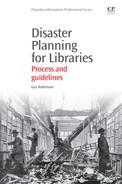Basic tabletop exercises
Abstract
No disaster plan is complete until library employees are familiar with it and prepared to carry out its guidelines and instructions. Orientation and training can be conducted through tabletop exercises, which include realistic disaster scenarios followed by tasks for library personnel who could be involved in response measures and operational resumption. Tabletop exercises are brief, and are intended to lead participants to useful conclusions about their library’s level of preparedness for disasters and their ability to resume operations after different kinds of events. Scenarios should be based on a library’s risk profile. All levels of staff should participate in exercises, and should be encouraged to contribute to them with comments and observations, which in turn can lead to the updating and enhancement of disaster plans.
Keywords
11.1. No plan without practice
Both in-house and external planners have to push library managers to read plans carefully and to make arrangements for staff members to test different components. In some libraries, it’s hard enough to get people to participate in simple fire drills, even when government regulations stipulate them. It can be even more difficult to get employees to test disaster plans, which can be more complicated. That’s why many planners recommend tabletop exercises to inform employees about their library’s disaster plan, and to test the plan.
They’re no more than 15 minutes. Sometimes only a few library staff members are able to attend, and that’s fine. I present the scenario, which could involve anything from a terrorist attack to a burst pipe in the washroom. Everyone in our library knows our disaster plan, and when they participate in coffee exercises they describe the best courses of action during and after the event. I’m always impressed by the intensity of our exercises, and the ways in which our people use the library’s disaster plan. It’s not perfect, and we discover weaknesses quite often – almost always through coffee exercises and the perspectives that they offer us.
‘You can hold tabletop exercises not only after a local disaster, but also after any disaster that merits a global focus’, says an emergency services coordinator in Ottawa. For example, Asian earthquakes often capture worldwide public attention, and people are more interested in finding ways to protect themselves, even if they do not live in seismic zones. That can be a good time to offer a tabletop exercise to employees in any library. You can tell them that you want to make sure that your plans are up to date and ready for activation, and chances are that employees will be eager to participate. They might not be as enthusiastic during times when things are relatively calm, and the media cover matters unrelated to disasters. The point is that you should take advantage of unfortunate events when they happen elsewhere, to prepare your library when something bad happens locally. That’s not cynical. That’s being practical and realistic.
11.2. Risk assessment and analysis example
Our school and my library had one exercise for hurricanes. It had been put together in the 1960s, and while parts of it were still relevant, it did not address the more important aspects of safety and recovery. And then 9/11 and Hurricane Katrina hit, and libraries in the southern US recognized the need for better planning, which involves a lot more training and practical exercises.
We talk a lot about Katrina and 9/11, and the Fukushima Daiichi nuclear disaster. But we need to prepare for things that are much more likely to happen, smaller disasters that strike libraries every day. That’s why the people in my library spend even more time talking about ruptured pipes and minor power failures than the really big disasters. I believe that we need to prepare for the broad spectrum of events, and the best way to do that is to conduct regular exercises with a variety of different scenarios.
